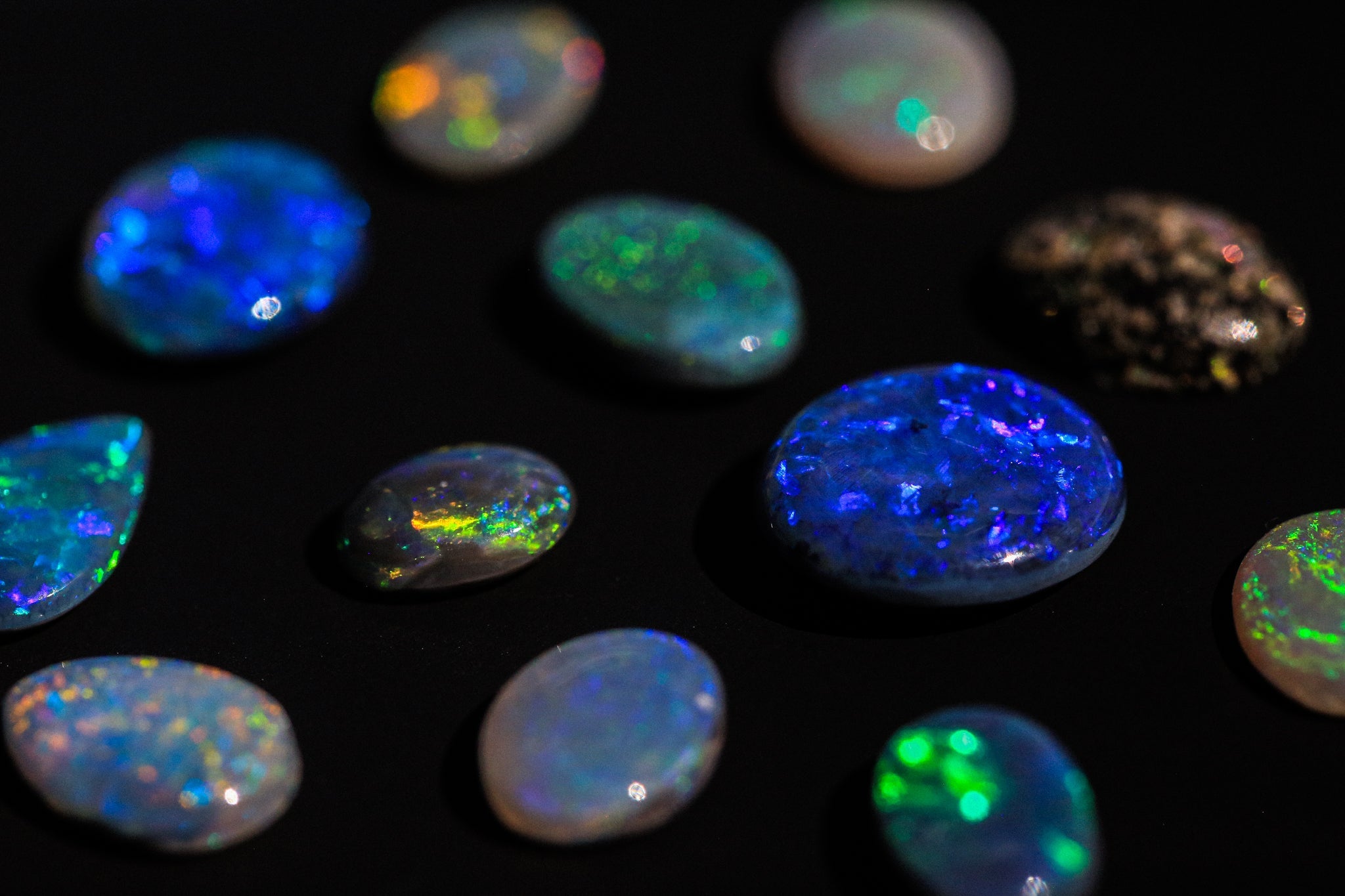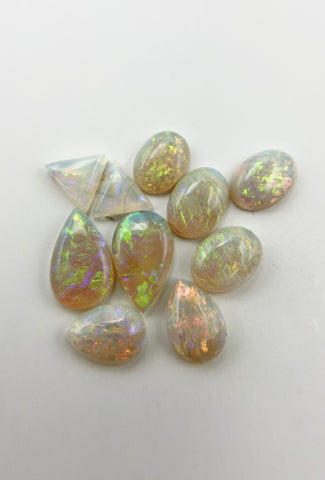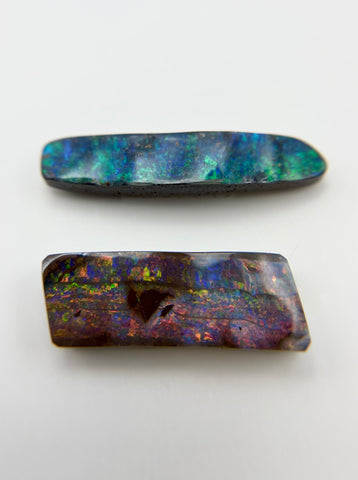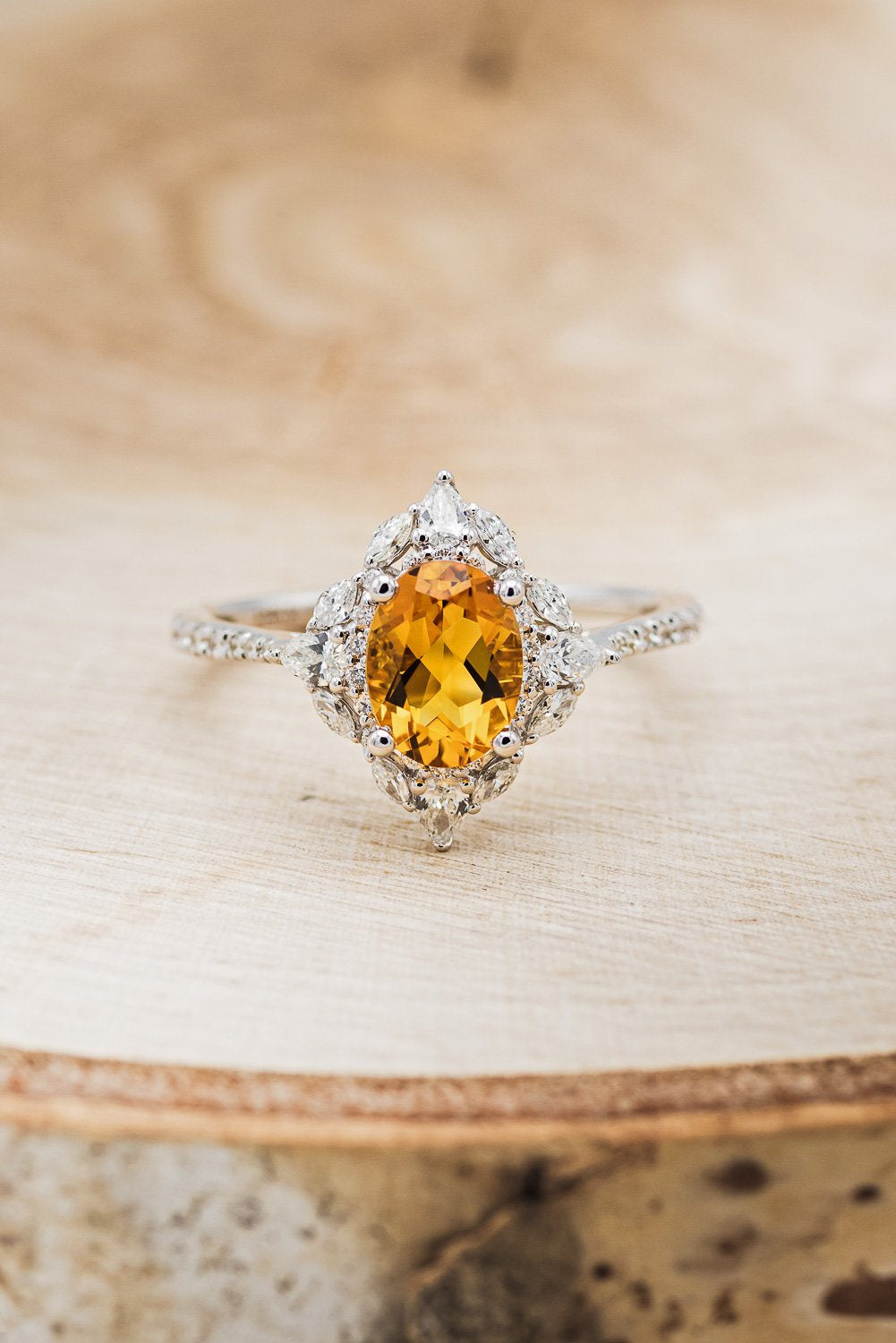
The Wonder From Down Under - Precious Opals
With its fireworks of rainbow color, opal has mesmerized mankind for ages and continues to be one of the most unique and valued gemstones on Earth. Much like snowflakes, no two precious opals will ever be the exact same! Opal is the birthstone of October and is often used as the gemstone of the 14th anniversary. Let's dive in to learn about the mysteries of this stunning stone from the "Land Down Under"!
Description & Sourcing
Opal is known for its hypnotic patterns of color and light. The different color flashes seen in opal are called “play-of-color” or simply “play”. However, not all opals have play-of-color! Opals without play are called "common opals" while gem-quality specimens with play-of-color are called "precious opal" or "noble opal." This incredible color phenomena is caused by small silica spheres within the structure of the gem diffracting light. It is much like the sun and rain combining to make a rainbow or white light shining through glass and creating a spectrum of color. Play of color can include every color in the rainbow, although some colors like green and blue are more common than red. The size of the spheres within the opal will help determine the colors it flashes - small spheres reflect blue while larger spheres reflect red. Opal is truly a fascinating marvel of nature and science!
Opal is formed in faults and fractures between layers of sediment of sandstone, claystone, and ironstone. Many years ago silica-rich water seeped into cavities in these sediments and solidified. In some cases, the opal formed within ancient volcanic deposits when silica dioxide, lava, and water mixed, as is the case with fire opal. There have even been fossils, shells, and wood found that has been "opalised," where the cavities left by dissolved fossils filled with the silica dioxide and water gel that solidified into opal. Miners often follow faults or obvious layers in the surface of Earth's crust in order to find opal deposits. Both open pits and underground mining methods are used to find opal.
Opal has been commercially mined in Australia since the late 1800s but historians believe opals have been adorned for much longer - possibly back to 4,000 B.C. In these times, it is believed that the precious gemstone was mined in places like Ethiopia, Hungary, and Mexico and were distributed among the wealthy. Opals were popular among Romans who believed the stone was the most precious of all gems for its variety of colors. In fact, the name "opal" is believed to have been derived from the Roman word opalus, meaning "precious stone." As history went on many folklores and superstitions were raised around opal and it eventually gained a reputation of being an "evil" stone. Even today, some people claim that it is bad luck to wear an opal if you do not have an October birthday. This belief originated when it was taken out of context out of an early 1800's novel. There is no factual basis for these superstitions and opal is considered very lucky in many cultures!
Today, society has developed techniques and technology to be able to grow opal in lab settings. Lab-grown opal has the same chemical composition and physical appearance as natural opal while being more cost effective! It is simply formed in a sped up process that mimics nature. In addition, it comes in a much wider variety of colors than natural opal, making the design possibilities endless!
Opal Varieties
There are many types and varieties of natural opal including but not limited to:
- Fire opal
- Boulder opal
- Light opal
- Black opal
- Yowah-nut opal
- Water opal
- Fire opal
- Leopard opal
- Exotic opal
Each type of opal has its own special properties and colors! Below are some of the most important and popular opal types.
Light Opal
Light opal is the most common opal variety and is what many people think of when they think of precious opal. It can have an opaque milky white appearance such as that of white opal or it can have a more yellow-ish and/or transparent color, which is called crystal opal for its clarity. Most light opal comes from Southern Australia but can also be found in smaller quantities in Brazil and Mexico. Especially in the sun, light opal flashes color like fireworks among a cloudy sky!

A variety of light opals in different sizes and cuts.
Fire Opal
Fire opals come in fiery shades of yellow, orange, and red and can have play-of-color or can be translucent without play. Translucent fire opals are unique in that they are often faceted rather than being cut into cabochons like other opals almost always are. Mexico is known for producing the highest quantity of high-quality fire opals in the world! Fire opal is found in ancient volcanoes after being formed from lava, silica, and water. Raw fire opal looks much like the lava it was formed from!
Boulder Opal
Boulder opals come from Queensland, Australia and were formed in thin veins between the matrix of host rocks and sediments like crystals within a geode. Boulder opals are left within the host rock when cutting and polishing, much like how geodes are found and cut. Matrix from the host rock, typically ironstone, can often be seen within the opal and can create very interesting patterns including the “church window” pattern which is mosaic-like pattern that looks like stained glass windows. The matrix found within boulder opals can also help them to be more durable. Yowah-Nut opals, a famous variety of boulder opal, share this unique appearance. These opals are mined in Yowah, Australia and are often shaped like nuts, hence the name! This type of opal is very popular among opal enthusiasts and collectors.

Two boulder opals from Australia.

A Yowah-Nut Opal from Australia.
Black Opal
Black opals are often considered the rarest and most valuable of all the opal varieties. They are mostly mined in Lightning Ridge, Australia and have a dark appearance, or "potch," which helps illuminate and contrast the bright flashes of color and play. Black opals are mostly mined by hand and are an extremely rare find - in fact they are rarer than the average 1ct diamond! While black opal play-of-color can showcase any color, blue and green are the most common and red the most rare and valuable. A common misconception is that black opals are always black, which is a common mistake. In reality, they simply have a dark potch that can be deep blue, grey, black, or other dark colors. Black opals have an apperance similar to a heat map or the Northern Lights against a dark sky.

A black opal with blue and green play-of-color.
Opal Care & Cleaning
Opal ranks between 5 and 6.5 on the Moh’s Hardness Scale, meaning it is a soft stone that requires special care in order to avoid breaking or scratching the stone. Warm soapy water and a soft cloth is the only recommended method for cleaning opal jewelry. Do not submerge opal jewelry in the warm water, instead wet a cloth and wipe the stone. Sudden temperature changes can cause opal to fracture so be sure not to use water that is too hot or too cold. Because opal has high water content, prolonged heat or light exposure can cause the stone to dehydrate and crack. Avoid wearing opal jewelry in these conditions. In addition, certain types of opal can absorb water which can cause temporary loss of play-of-color and other effects. Welo opal, also known as Ethiopian opal, is an example of one of these "hydrophane opals," opals that absorb moisture like a sponge. While the opal's play can return to normal after releasing some moisture, it is best to avoid these situations altogether to avoid issues or damage. Do not use steam or ultrasonic cleaners on opal jewelry.
Welo opal, like the one seen above, is a hydrophane opal, meaning it can absorb water.
While opal is one of the more fragile gemstones available and requires special delicate care, with proper attention it can last a lifetime. Avoid bumping, rubbing, or hitting your opal ring as much as possible. Always remove jewelry before participating in any activities that could pose a risk to your ring or hands. Remove your jewelry before participating in activities like:
- Manual labor including household chores (dishes, laundry, cleaning, etc.)
- Sports, going to the gym, gripping things with force (handlebars, luggage, etc.),
- Using chemicals such as chlorine or bleach
- Swimming, using a sauna or hot tub, showering, etc.
- Applying cosmetics, lotion, perfume, etc.
- Sleeping
- Brushing hair or getting dressed (hair or thread can get caught on the prongs of your jewelry causing them to loosen and increase the risk of your stone falling out)
These are some of, but not all of the activities which could pose the risk of damaging your ring. Each ring order we fulfill includes a complimentary silicone ring that can be worn in place of your custom ring when you participate in these types of activities!
Store opal jewelry away from other jewelry because the metal or stones in them can scratch and damage the opal.
Read more about ring care and cleaning in our Care Guidelines section of our site.
Designing a Custom Ring With Opal
Despite being a soft stone that requires extra care, to many the extra care is worth it in order to enjoy the incredible and unique beauty of opal! A well cared for opal can last for many years. Whether you have an October birthday or simply just enjoy its look, opal is a great way to add a meaningful and personal touch to a piece of custom jewelry! At Staghead Designs, we enjoy working with opals and have been able to work with a wide variety of opal colors and types. Opal serves as a beautiful center stone or accent material regardless of whether the ring is a more feminine or masculine design! We use natural opals for our center stones and crushed lab-grown opal as one of our many ring inlay options and have many color variations to choose from including:
- Fire & ice opal
- Blue opal
- Cotton candy opal
- Black cherry opal
- Sleepy lavender opal
- White opal
- Red opal
- Magma opal, and more!
This 14K rose gold wedding band has a lab-grown crushed sleepy lavender opal lining & hammered finish.
Browse our collections of customizable made-to-order designs here. Because our rings are customizable you can easily switch out materials and replace them with opal or other material options. Want to start with a center stone first & then create a design around the stone? Check out the Staghead Mine to see our collection of rare hand-selected stones including some incredible Lightning Ridge opals like the ones pictured below! Choose your dream stone and then work with our designers to create a stunning one-of-a-kind ring. Want to start completely from scratch in designing your ring? We offer that too! Contact us to start designing the ring of your dreams today!






